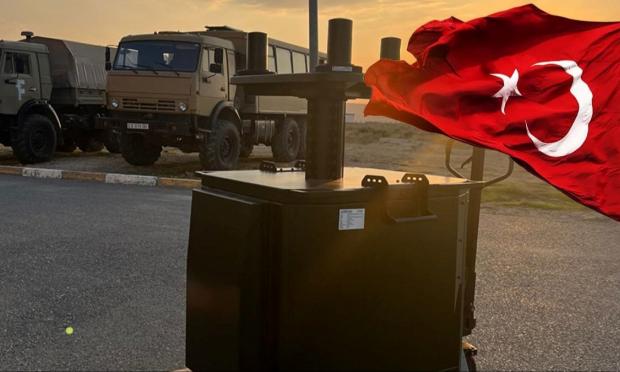Unfortunately, the assessment of PENTAPOSTAGMA, according to which in our article of September 3 entitled "New war "in the making"! Azerbaijan's warning to Armenia: "You are playing with fire", we warned that "the mixture is explosive and our conviction is that sooner or later, it is very likely that the two countries will be led to a resumption of their military confrontation", referring to Azerbaijani-Armenian relations, was fully verified.
In today's article entitled," Massive Azerbaijani attack on Nagorno Karabakh - Bombardments against civilians with MLRS, UAVs - Children taken to "Arevik" hospital," we thoroughly reported with a wealth of visual material, on the large-scale attack, of the Armed Forces of Azerbaijan, using artillery and drones, against Nagorno Karabakh, targeting cities and civilians, which is ongoing and closely monitored by us.
Turkey-Azerbaijan relations are fraternal, as Erdogan is wont to say, with the two countries cooperating closely in the military field and Ankara constantly reinforcing Baku with weapons systems and means, having as a cornerstone the provisions of the "Susa Declaration".
Turkey has exported the anti-drone electronic warfare system 'ILTER' to Azerbaijan
As part of Turkey's military assistance to Azerbaijan, Turkish media in an article titled, "ILTER solution for drone threats! Turkey sits down at the table with our sister country", points out the following:
"İLTER, which is an electronic warfare system developed by the Turkish defense industry to neutralize drone threats, continues its export success.
According to the information received, the İLTER Drone Detection and Blocking System product family, developed by Boğaziçi Defense with its domestic production participation of over 90%, continues to be in demand at home and abroad thanks to its performance in the field.
Boğaziçi Defense, which managed to export İLTER to more than 10 countries, exported new drone countermeasure systems to Azerbaijan, where it previously supplied its other products.
After the tests carried out in Turkey with the representatives of the Ministry of National Defense of Azerbaijan, the delivery of the İLTER J250 Drone Detection and Interception System and the İLTER HP Mobile High Power GNSS Deception and ISM Intercept System models was delivered.
Different system requests received from Azerbaijan will also be presented to the authorities in the coming days.
The İLTER J250 Drone Detection and Blocking System, the newest member of the İLTER family, performs fully automatic detection, jamming and deception operations against rotary or fixed-wing mini/micro drones with its RF sensors.
The system, which has 360-degree detection and interdiction capabilities against multiple drone attacks, can detect up to 8 km distance and spoof coordinates in GNSS bands.
Thanks to its coordinate spoofing capability, the system emits fake GNSS signals to deter threats flying autonomously and can move the threat from the protected area to the desired coordinates.
The İLTER HP Mobile high-power ISM GNSS fake and blocking system, with its long effective range and mobility, can block target points up to 80 kilometers from safe areas.
With the visual contact software that calculates the target points affected by the system, the antennas in the system are automatically directed to the target and jamming can be achieved without loss, blindness and deception.
The system, installed in a closed 4x4 vehicle, can operate continuously 24 hours a day.
Detects Drones/UAVs with RF spectrum RF output power standard 250 W.
360° detection and suppression against multiple drone attacks
Detects horizontally at least from 1 km to 8 km and vertically up to between 40° and 60°.
User-friendly interface.
Engagement ratio range of at least 1:2, typical 1:5
Wander in GNSS bands.
Detects low altitude UAV (Unmanned Aerial Vehicle) with rotating and fixed wings, the drone's wireless communication with its remote control,the UHF, S ve C frequency bands
Blocks the frequency bands of remote control communications with enemy Drone/UAVs, and
autonomous flights based on GNSS frequency bands (GPS(L1,L2,L5), GLONASS(G1,G2,G3), GALILEO(E1,E5a,E5b,E6), BEIDOU(B1,B2,B3)).
With user-defined fake GNSS signals generated by ILTER it misleads the hostile threat.
It is well known that Tehran does not look favourably on the opening of the Zangezur corridor and the land connection between Turkey and Azerbaijan, since it will be extended through the Caspian Sea, linking the countries of the Turkish world commercially, economically and militarily, creating a "Turkish NATO" on its borders.
At the same time, it will cut the connection between Iran and Armenia, which is vital for Tehran to maintain a land connection with Russia.
It is also known to "host" an Israeli Iranian surveillance base on Azerbaijani territory, so it follows that Tehran is hostile to Baku.
Finally, there were unconfirmed reports of reinforcement of Armenia with Iranian drones, and the destructive capabilities of the Iranian kamikaze "Shahed" drones given to Russia and used extensively against the Ukrainians are well known.
Our assessment is that before the risk of destruction of Azeri weapon systems and means by Iranian drones possessed by Armenia, the Turkish President decided to equip Baku with the modern anti-drone system "ILTER".



